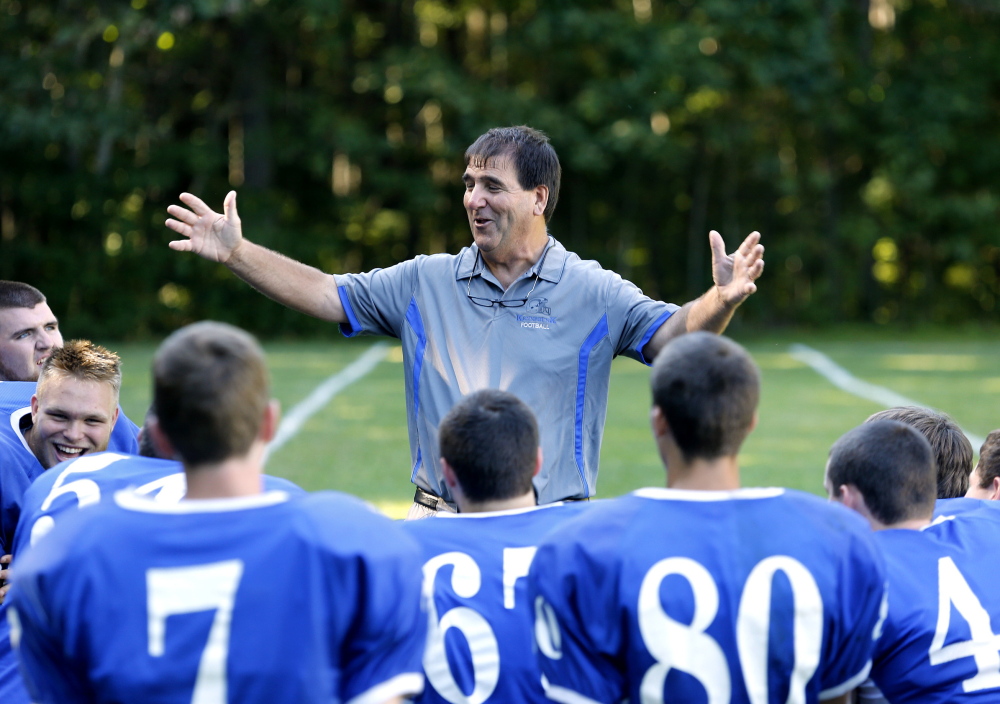AUGUSTA — Changes could come to Maine high school football next season, although nothing was decided Monday at a meeting of the Maine Principals’ Association football committee.
The committee met with coaches and athletic directors from the state’s eight conferences for more than 2 hours, brainstorming ways to make the sport more competitive and help programs near collapse.
“I just don’t think we can stay idle,” said Dan O’Connell, the John Bapst coach.
Over the last few seasons, schools have seen participation numbers fall, some schools dropping varsity teams for club or junior varsity status.
Varsity teams at Sacopee Valley, Telstar, Camden Hills and Boothbay Region are gone, and some other schools may be in jeopardy of not having enough players to field a team next season.
Some larger schools also report dwindling numbers.
Mike Burnham, an assistant executive director of the MPA and liaison to the football committee, said he took calls from two Class B schools struggling with low participation last season. A lack of competitive balance is a common problem in each of the state’s four classes, Burnham said.
“We can’t lose sight of (the fact) there were 21 schools with two or fewer wins (this past season),” Burnham said.
Among solutions discussed were expanding to five classes, adding a developmental league or playing seven-, eight-, or nine-man football, or tiering schedules as is done in hockey.
“With tiers similar to hockey, ultimately you get more competitive games. I think Winslow this year would much rather have played Skowhegan than John Bapst,” O’Connell said, pointing to his team’s 56-6 loss to the powerful Black Raiders.
A tiered schedule would encourage teams to play cross-class games, although consensus was a change would need to be made to the playoff formula.
Playoff seeding is done using Crabtree points, which take into account a team’s record and the record of its opponents.
Crabtree Points don’t account for competing against schools in a different class. The lack of a points incentive was a reason Wells didn’t play cross-class games, said Coach Tim Roche.
“There’s no benefit for us to do that,” he said.
Added Kennebunk Coach Joe Rafferty: “I’m going to need a big incentive to go to (Class A) Thornton (Academy).”
Since the introduction of four classes in 2013, Rafferty’s team has enjoyed success in Class B, reaching the state final in 2013 and this past season.
“When we were in Class A, we went 4-4 twice. Now we go to Class B, we have success. Not a lot has changed with our program,” he said.
An eight- or nine-game football schedule also makes it more difficult to be more creative.
“There’s a lot more flexibility in hockey and basketball because of 18 games. It’s going to be hard with a limited schedule,” Lewiston Athletic Director Jason Fuller said.
Fuller suggested seven-, eight-, or nine-man football for programs struggling to find players to field a competitive team of 11.
“We’ve never tried something completely out of the box,” Fuller said. “It gives them a product nobody else has. It’s very innovative.”
Winthrop Athletic Director Joel Stoneton said he doesn’t think struggling and smaller schools are interested in competing with fewer players.
There was some support for adding a fifth class, including from Roche, whose Wells team won the Class C state title last month. With fewer teams playing in each class, scheduling crossover games between the North and South would be a necessity. Wells played northern teams in the past and would do so again if it meant more competitive games.
“While I don’t like to travel, I like to play Winslow,” Roche said.
Bonny Eagle Coach Kevin Cooper said the problem is less about the number of classes and more about competitive balance.
“Class fixes nothing, in my opinion. You can have five classes or three classes. It’s just putting tiles in a bag and shaking them up,” said Cooper, whose team won the Class A state title last month. “It’s all about scheduling. The more we do creative scheduling, the more Crabtree points don’t work.”
Cooper said whatever is done for 2017, it must help struggling programs.
“Sacopee Valley should be saved. They should have a thriving football program,” Cooper said.
Lower football participation is also a by-product of smaller schools in general, said an MPA assistant executive director, Gerry Durgin.
The committee hopes to have a plan for 2017 by mid-February, when the MPA wants to send it to all schools for feedback.
The full membership then will hold a vote on an alignment in April.
CORRECTION: This story was updated on Dec. 6 at 4:15 p.m. to clarify that some schools may be in jeopardy of not having enough players to field a football team next season.
Send questions/comments to the editors.




Comments are no longer available on this story